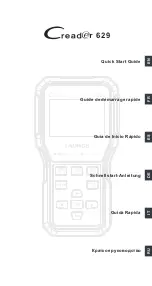
105
105
Test and Calibration
CALIBRATION
Most of the calibration parameters are determined
by a computer aided calibration procedure after
burn-in at the factory. These calibration parame-
ters are stored in the permanent memory of each
unit. The calibration mainly involves setting the an-
alog thresholds and levels accurately.
This section details the calibration of the signal in-
puts which, because of their high speed, require
some hand adjustment. In addition, the repair pro-
cedure for the signal inputs is discussed.
CAUTION
See the diagram at the beginning of the
circuit description to locate the circuit
boards inside the chassis.
ALWAYS disconnect the power cord
and wait at least two minutes before
opening the unit. Dangerous power
supply voltages may be present even
after the unit has been unplugged.
Check the LED at the front edge of the
power supply board. The unit is safe
only if the LED is OFF. If the LED is
ON, then STAY AWAY from the power
supply board.
This unit is to be serviced by qualified
service personnel only.
WARNING
The calibration procedure requires adjusting the
instrument with power applied and so there is a
risk of personal injury or death by electric shock.
Stay away from the power supply board while the
unit is plugged in.
Please be careful.
Turn the power off, disconnect the power cord,
wait two minutes, then remove the top cover of the
chassis. Plug the unit back in and turn on the pow-
er.
SIGNAL INPUT OFFSET
To calibrate the input offset, connect a voltmeter to
the signal input. P101 adjusts the voltage which is
output from the signal input. This output voltage
should be set to 0V. The potentiometer is located
on the ECL board (lower board) behind the signal
input BNC. Use a small screwdriver from the top
and adjust the potentiometer for a reading of 0 ±
0.1 mV on the meter.
SIGNAL INPUT REPAIR
The diodes in the overload protection circuit can
be damaged by excessive voltages at the inputs.
To check for damage, measure for 0.6 V across
the diodes in D101. D102 and D103 can be tested
by removing them from the circuit and then check-
ing for degradation of the amplifier's pulse re-
sponse as each diode is reconnected. The amplifi-
er outputs can be viewed with a fast oscilloscope
across R239. Replacement diodes are available
from the factory.
Performing these adjustements or replacements
can result in the discriminator levels being slightly
miscalibrated. The discriminator offsets may be a
few mV larger after repair or adjustement.
Remove the power cord and wait two minutes be-
fore replacing the cover. This allows the power
supply to discharge and removes the possibility of
shorting out a circuit with the cover while replacing
it.
Summary of Contents for SR430
Page 2: ......
Page 6: ...4 ...
Page 22: ...20 Guide To Operation ...
Page 26: ...24 Guide To Operation ...
Page 36: ...34 Mode Menu ...
Page 54: ...52 Save Menu ...
Page 60: ...58 Recall Menu ...
Page 70: ...68 Plot Menu ...
Page 74: ...72 Test Menu ...
Page 76: ...74 Info Menu ...
Page 97: ...96 Remote Programming ...
Page 99: ...98 98 Program Examples ...
Page 107: ...106 106 Test and Calibration ...
Page 113: ...112 112 Using Photomultiplier Tubes ...
Page 125: ...124 124 124 Circuit Description ...
















































